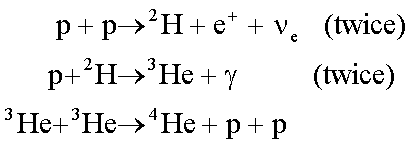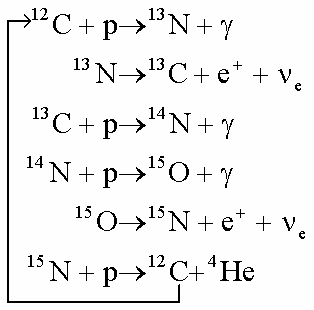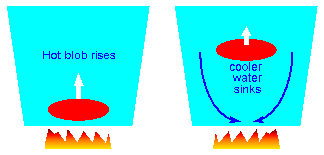

|
Astronomy 162:
Introduction to Stars, Galaxies, & the Universe
Prof. Richard Pogge, MTWThF 9:30
|
Lecture 13: Energy Generation & Transport in Stars
Readings: none, but see Ch 18 section 18-2
- Energy generation in stars:
- Nuclear Fusion in the core.
- Controlled by a Hydrostatic "thermostat".
- Energy is transported to the surface by:
- Radiation (photons)
- Convection (gas motions)
- Conduction
- Thermal Equilibrium in Stars
Putting Stars Together
Physics needed to describe stars:
- Law of Gravity
- Equation of State ("gas law")
- Principle of Hydrostatic Equilibrium
- Source of Energy (e.g., Nuclear Fusion)
- Way to transport that energy to the surface.
Hydrostatic Equilibrium
Balance between Pressure & Gravity.
- If Pressure dominates, the star expands.
- If Gravity dominates, the star contracts.
Sets up a Core-Envelope Structure:
- Hot, dense, compact core.
- Cooler, low-density, extended envelope.
Energy Generation
Stars shine because they are hot.
To stay hot stars must make up for the energy lost by shining.
Two Energy sources are available to stars:
- Gravitational Contraction (Kelvin-Helmholtz)
- Nuclear Fusion in the hot core.
Without a source of internal energy, a star would eventually cool
off and go out.
Main-Sequence Stars
Generate energy by fusion of 4 1H nuclei (protons) into 1
4He nucleus.
There are two nuclear reaction paths by which a star might accomplish
this fusion:
Proton-Proton Chain:
- Relies on proton-proton reactions
- Dominates at low core Temperatures (TC<18M K)
CNO Cycle:
- Carbon acts as a catalyst
- Dominates at high core Temperatures (TC>18M K)
Fuse Hydrogen into Helium via a three-step nuclear reaction chain:

Notice that the p-p chain uses 6 protons in all, and ends up with 1
4He nucleus and 2 protons at the end, for a net conversion of
4 protons into 1 Helium, with the release of energy as gamma-ray
photons, neutrinos, and positrons.
Fuse Hydrogen into Helium via a multi-step nuclear reaction cycle
catalyzed by Carbon:

Notice that the CNO cycle starts with one 12C nucleus in step
one, and add 4 protons during each of steps 1, 3, 4, and 6. At the end,
you get a 4He nucleus and the 12C nucleus. This
12C nucleus is ready to once again jump back into the
cycle.[13.1]
The result is a net conversion of 4 protons into 1 Helium nucleus, with a
release of energy in the form of gamma-ray photons, neutrinos, and
positrons.
Because 12C is not consumed by this process (it goes in at the
top & comes out at the end), we say that it acts as a catalyst
in this nuclear reaction.
Because Carbon and Nitrogen have 6 and 7 protons, respectively, in order
to overcome the repulsion of all these positive charges the protons must
be moving very fast. This is why the CNO cycle occurs at higher
temperatures than the P-P chain. The Sun only gets about 2% of its energy
from CNO, but in slightly larger stars, about 1.1Msun, CNO
accounts for 50%, and then dominates the energy production at all higher
masses.[13.2]
Controlled Nuclear Fusion
Nuclear fusion reactions are Temperature sensitive:
- Higher Core Temperature = More Fusion
BUT,
- More fusion makes the core hotter,
- Hotter core leads to even more fusion, ...
Why don't stars explode like a Hydrogen Bombs?
Hydrostatic Thermostat
If the fusion reactions run too fast:
- The core heats up, leading to higher Pressure.
- Higher Pressure makes the core expand against gravity.
- Expansion cools core, slowing the rate of fusion.
If the fusion reactions run too slow:
- The core cools, leading to a lower Pressure.
- Lower pressure makes the core contract under gravity.
- Contraction heats core, increasing the rate of fusion.
Result is like a thermostat: an increase or decrease in the rate of
fusion results in a compensating response by the gas in the core. This
prevents either runaway heating and explosion or a runaway collapse.
We need to start with a basic principle of thermodynamics:
- Heat always flows from hotter regions into cooler regions.
In a star, heat must flow:
- From the hot core where the fusion is.
- Out through the cooler envelope,
- To the surface where it is radiated away into space as light.
Energy Transport
There are 3 ways to transport energy away from a heat source:
- Radiation: Energy is carried by photons
- Convection: Energy carried by bulk motions of the gas
- Conduction: Energy carried by particle motions
Radiation
Energy is carried by photons radiating away from the heat source. If
we follow an average photon emitted in the core, its path outward
to the surface is as follows:
- Photon leaves the core
- Hits an electron or atom within ~1-mm and gets scattered.
- Slowly staggers to the surface in a "random walk"

On average, it takes about 200,000 years for a photon from the core
to random walk its way to the surface.[13.3]
Convection
Energy carried from hotter regions below to cooler regions above
by bulk buoyant motions of the gas.
Everyday examples of convection are boiling water and hot air "rising" off
of a candle flame or a radiator.

In the figure above
- Hot water near the flame becomes buoyant and rises against gravity.
- As it rises, it displaces cooler water downward
- When it reachs the top, it gives up its heat to the surrounding cooler
water
- Cool water displaced downward heats and repeats the cycle
Result is to setup a circulating "convection flow" in the liquid ("boiling").
The analoguous process can occur in some stars. Convection becomes
efficient when the gas in the hot layers of a star cannot pass radiation
through it effectively.
Conduction
Heat is passed from atom-to-atom in a dense material from hot to cool
regions.
Example: Hold the a spoon by the handle and put its bowl into a
candle flame. Over time, heat will get conducted from the bowl up the
handle and you will feel it heat up. If you hang on too long, it will
become so hot you will burn your fingers.
Conduction is most efficient when the densities are very high (atoms or
electrons packed in close proximity to each other).
Energy Transport in Stars
Normal Stars:
- A mix of Radiation & Convection transports energy from
the nuclear fusion site in the core to the surface.
- Conduction is inefficient (the density is too low).
White Dwarfs:
- Ultra-dense stars (~105 g/cc) with no nuclear
fusion in the core.
- Conduction dominates energy transport.
- Results in a nearly uniform temperature from core to surface
Thermal Equilibrium in Stars
A star will be in Thermal Equilibrium when the amount of energy
generated in the core is balanced by the transport of that energy to the
surface to be radiated away as starlight.
- Energy Generation = Star's Luminosity
Thermal equilibrium is a delicate balance:
- Generate more energy than required by the star's Luminosity, the
excess energy makes the star expand.
- Generate less energy than required, and the deficit is made
up by the star contracting.
Thermal equilibrium plays a vital role in the evolution of stars.
Summary:
Energy generation in stars:
- Nuclear Fusion in the core
- Controlled by a Hydrostatic "thermostat"
Energy generated in the core is transported to the surface by:
- Radiation & Convection in normal stars
- Conduction in white dwarf stars
The balance between energy generation and energy transport is called
Thermal Equlibrium.
Along with Hydrostatic Equilibrium, these determine the detailed structure
and evolution of a star.
Return to [
Unit 2 Index
|
Astronomy 162 Main Page
]
Updated: 2006 July 31
Copyright © Richard W. Pogge, All Rights
Reserved.





